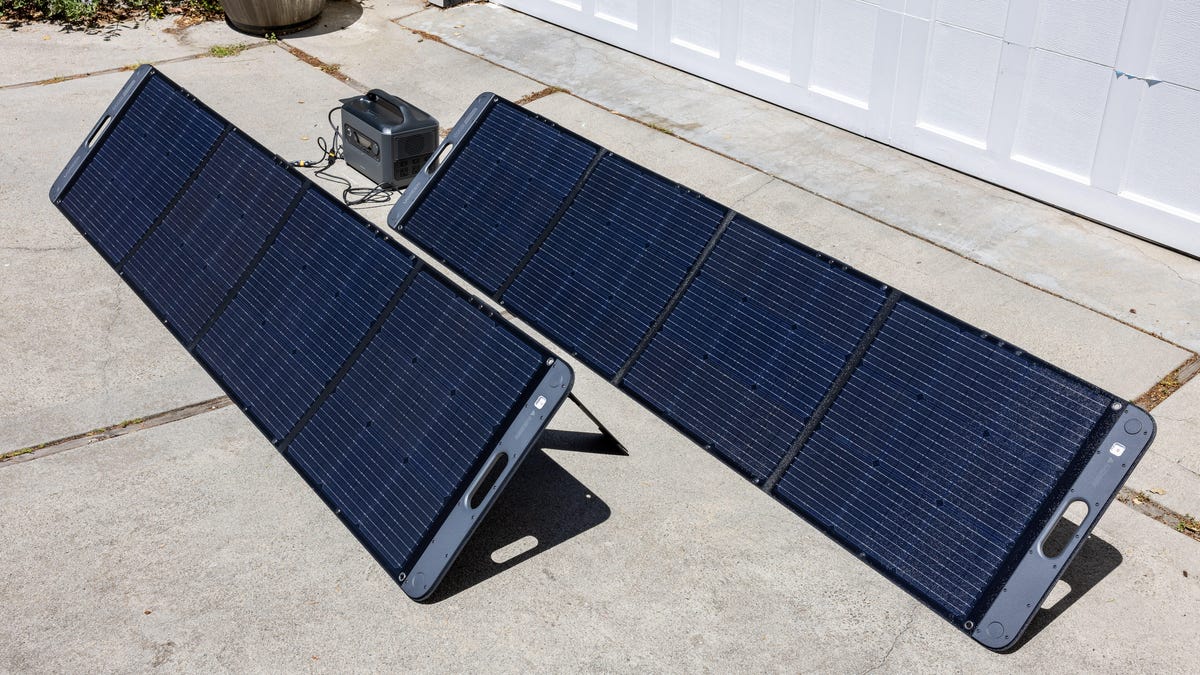When high winds took down power lines and left my family in the dark last March — twice — our difficulties were eased by a large battery we used to run our broadband router and charge phones. But with no way of knowing when power would come back on, I watched closely as its remaining charge percentage dropped hour by hour.
Which is why I was intrigued by Ugreen’s PowerRoam 1200 Solar Generation product, which combines a pair of the Hong Kong-based company’s 200-watt folding solar panels with its PowerRoam 1200 battery. I’ve been testing it for a few weeks.
In short, I like it. I still get a giddy sensation watching the watts pour in just from sunlight. Under the best circumstances I could set up at my house, the panels generated 237 watts, which is close to the 250-watt maximum the system can produce. Charging from 0% to 100% took a little under 7 hours on a sunny day.
The package, with a 1,024Wh battery and the pair of fold-out four-panel panel sections, costs $1,299. That’s not cheap.
But if you’re worried about the next power outage, or you like RV road trips, the solar panel-battery combo is a great option. With the frequency and length of power outages increasing in the US, and climate change expected to make the grid less reliable, panels and a battery can be worth the investment.
If you’re in the market, check my colleague Andrew Blok’s assessment of portable solar panels. His top pick is the Jackery SolarSaga 200.
As I type this, my laptop is recharging its battery from the system, drawing 56 watts of power. My broadband modem and router take another 20 watts. Add in a couple phones and another laptop, and the battery has enough juice to last well over 10 hours. (Battery powered devices need more power when recharging than when in use.) It’s nowhere near big enough to live off the grid, but I was able to use the battery to power my refrigerator for about 6 hours during warm weather. It uses 122 watts when its compressor is running.
I liked this tool that helps you aim Ugreen’s solar panels straight toward the sun. When the dark shadow spot is right behind the red dot, you’ll get top power generation.
Bulky but easy to set up
I had no trouble figuring out how to set up and use the system: unfold the panels, swing out the kickstands to orient the panels toward the sun with a built-in aiming system, then attach a cable from each panel quartet to a third Y-shaped cable that plugs into the battery.
But there’s manual labor involved. The 26-pound battery is heavy, though its built-in handle makes it manageable. The panels have a competitive 23% efficiency rating but are unwieldy despite their handles and weigh 19 pounds per section. For best results, you have to babysit the panel orientation, shifting them every hour or two to point toward the sun for top efficiency.
That can involve fiddling with each section’s four kickstands and dragging them around to avoid shade. I learned through testing that micromanaging the panel orientation to maximize power isn’t really necessary if you can expect several hours of solid sunlight.
At nearly 8 feet wide, the panels take a lot of space in your yard, campsite or boat. I’d like to be able to orient the panels toward the sun better with high-angle sunlight, but the built-in kickstands only let you lean the panels back partway. So during midday use, I just laid the panels flat or propped them against a wall.
You can’t easily power your home network system in a basement or office when the battery is outside charging. You could get two batteries, though, and swap them out. Or if your layout permits, you can run an extension cord from the battery to your device.
Broken plastic housing
The panels have magnets and snaps to keep them folded up during storage or when you’re schlepping them. However, on one of my sections, the magnet was stronger than the plastic of the electronics connector. The connector cover now partially pulls away from the panel, and I worry that manhandling the panels for optimal power generation will cause more damage.
The battery itself is good, though not perfect for my needs. It’s got two USB-C charging ports and two old-style USB-A charging ports. Lots of people need both, of course, but I have vastly more USB-C devices in my life and would rather have three or four. You can always plug phone or laptop chargers into the six AC power plugs on the battery’s side, but that lowers efficiency since the battery’s DC power must be converted to AC for the plug, then your charger has to convert it right back to DC to charge your device.
The battery also has a convenient LED light and a 12-volt car charger port so you can charge from your car or RV while you’re driving. You can also set the battery up as a uninterruptible power supply to keep devices like your home broadband running even if the power goes out.
If you’re charging from your own home’s power, you plug the battery in with its included power cord. It charges pretty fast: from flat to 80% full in 50 minutes. I wish you could charge over USB-C, though, which would be convenient for my electronics ecosystem even though it’s not as fast as plugging into a wall socket..
Unlike all the lithium-ion batteries in phones and laptops these days, the Ugreen battery uses a different chemistry, lithium ion phosphate. The chief advantage is a longer lifetime — it can go through 3,000 charge-discharge cycles, the company said.
I didn’t test long enough to get anywhere near 3,000 cycles. But because my main use case is coping with power outages in the years to come, I welcome the longevity.

